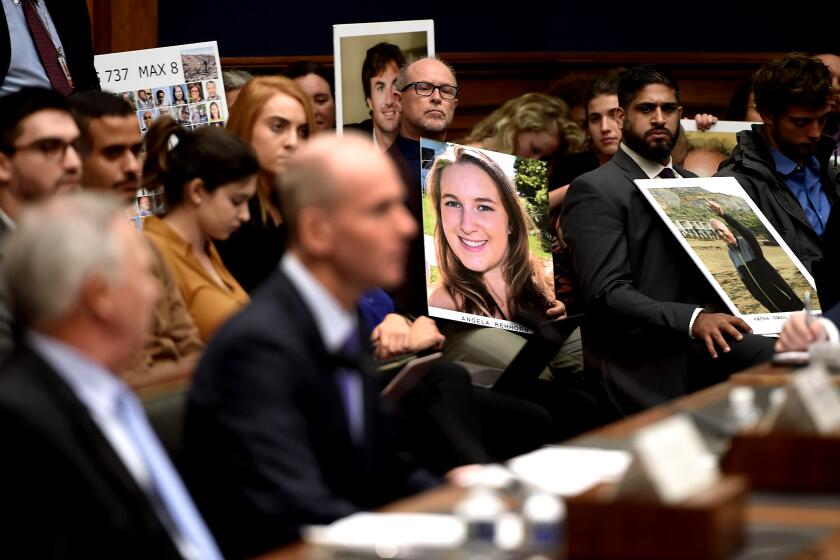Boeing is fixing a new software bug on the 737 Max as key flight approaches
- Share via
Boeing Co. has discovered a new software problem on the grounded 737 Max, but the company said the flaw would not set back the goal of returning the plane to service in mid-2020.
The plane maker identified the issue during flight testing and notified the Federal Aviation Administration last month, according to an email Thursday from Boeing. The problem was that an indicator light, designed to warn of a malfunction by a system that helps raise and lower the plane’s nose, was turning on when it wasn’t supposed to, the company said.
“We are incorporating a change to the 737 Max software prior to the fleet returning to service to ensure that this indicator light only illuminates as intended,” the company said.
The new software problem complicates Boeing’s efforts to return the Max to service by mid-2020, even if it doesn’t derail the recently extended timetable. FAA chief Steve Dickson, told reporters in London that a certification flight for the grounded jet could occur in the next few weeks — a key regulatory step in allowing the aircraft to start flying passengers again.
Dickson said the FAA was evaluating the latest software issue.
The stabilizer trim warning light “had been staying on for longer than a desired period,“ he said without providing more detail.
Boeing shares seesawed during Dickson’s remarks. They closed up 3.6% at $341.43.
Aviation regulators are closely aligned on design requirements for the Max but may differ country-by-country on when the jet returns, Dickson said.
The divergence is likely even though authorities agree more than they disagree on the measures needed for Boeing’s best-selling plane to resume flying after two fatal crashes, Dickson said.
The FAA has retained a strong working relationship with the European Union Aviation Safety Agency and other regulators during the Max crisis, Dickson said. The debacle has spurred questions about whether the FAA’s oversight was too lax when it approved the plane’s software design, which has been linked to both crashes.
The U.S agency will consult with other regulators on how to handle future approvals for enhancements to existing aircraft under the so-called changed-product rule, Dickson said. Updating an existing model, such as the 737, currently can be done without extensive scrutiny of aspects that don’t change. But following the crashes, critics have said regulators should conduct more thorough reviews.
Any shift could affect certification of 777X, a re-engined, re-winged update of Boeing’s twin-aisle plane. The 777X, which has folding wing tips, took its first flight last month and is expected to debut commercially next year.
Asked about a likely date for a return to service for the Max, Dickson said it wasn’t helpful to talk about timelines. Boeing needs to concentrate, he said, on making complete, quality submissions on its fixes for the plane.
The former Delta Air Lines Inc. pilot reiterated that he planned to fly the Max himself before it returned to the skies.
The FAA may need to expand its budget to improve its capabilities to assess aircraft designs in the wake of missing safety issues on the Max, Dickson said. But he said the agency didn’t need much to enhance its existing resources.
The new software issue on the Max resulted from Boeing’s redesign of the two flight computers that control the 737 Max to make them more resilient to failure, according to people familiar with the matter.
The problem involves an alert designed to warn when the so-called trim system, which helps raise and lower the plane’s nose, isn’t working properly, said the people, who asked not be named because they weren’t authorized to comment on it.
One of the people confirmed Boeing’s assessment that the new flaw wasn’t likely to change the plane’s projected return to service because the company had built padding into its schedule.
Boeing last month announced it didn’t expect the plane to fly again until the middle of the year. After months of missed deadlines and growing tension with the FAA, the Chicago-based company said it was estimating a timeline that included extra room in case new issues arose.
Separately, the manufacturer was already at work on a software system called the Maneuvering Characteristics Augmentation System. The MCAS system was involved in the two fatal crashes, which killed 346 people and led to the grounding on March 13.
More to Read
Inside the business of entertainment
The Wide Shot brings you news, analysis and insights on everything from streaming wars to production — and what it all means for the future.
You may occasionally receive promotional content from the Los Angeles Times.











